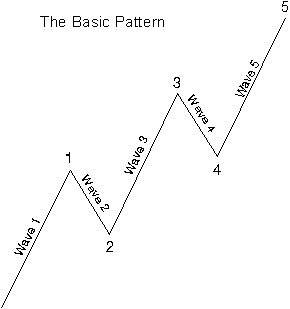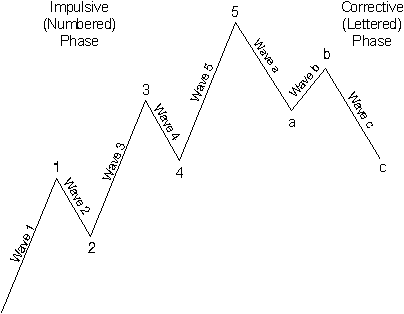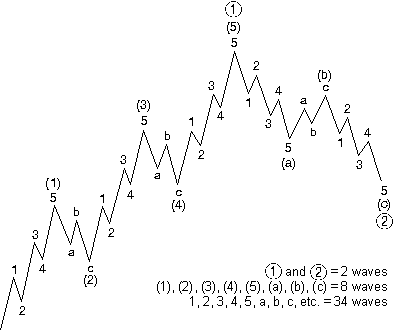- 22 Dezember 2017
- 208
- 124
Hier der Link:
Hier ein Auszug:
Basic Tenets of the Elliott Wave Principle
„The Wave Principle“ is Ralph Nelson Elliott‚Äôs discovery that social, or crowd, behavior trends and reverses in recognizable patterns. Using stock market data for the Dow Jones Industrial Average (DJIA) as his main research tool, Elliott discovered that the ever-changing path of stock market prices reveals a structural design that in turn reflects a basic harmony found in nature. From this discovery, he developed a rational system of market analysis.
Under the Wave Principle, every market decision is both produced by meaningful information and produces meaningful information. Each transaction, while at once an effect, enters the fabric of the market and, by communicating transactional data to investors, joins the chain of causes of others’ behavior. This feedback loop is governed by man’s social nature, and since he has such a nature, the process generates forms. As the forms are repetitive, they have predictive value.
Elliott isolated thirteen „waves,“ or patterns of directional movement, that recur in markets and are repetitive in form, but are not necessarily repetitive in time or amplitude. He named, defined and illustrated the patterns. He then described how these structures link together to form larger versions of the same patterns, how those in turn are the building blocks for patterns of the next larger size, and so on. His descriptions constitute a set of empirically derived rules and guidelines for interpreting market action. The patterns that naturally occur under the Wave Principle are described below.
The Five Wave Pattern
In markets, progress ultimately takes the form of five waves of a specific structure. Three of these waves, which are labeled 1, 3 and 5, actually effect the directional movement. They are separated by two countertrend interruptions, which are labeled 2 and 4, as shown in Figure 1. The two interruptions are apparently a requisite for overall directional movement to occur.

Figure 1
At any time, the market may be identified as being somewhere in the basic five wave pattern at the largest degree of trend. Because the five wave pattern is the overriding form of market progress, all other patterns are subsumed by it.
Wave Mode
There are two modes of wave development: impulsive and corrective. Impulsive waves have a five wave structure, while corrective waves have a three wave structure or a variation thereof. Impulsive mode is employed by both the five wave pattern of Figure 1 and its same-directional components, i.e., waves 1, 3 and 5. Their structures are called „impulsive“ because they powerfully impel the market. Corrective mode is employed by all countertrend interruptions, which include waves 2 and 4 in Figure 1. Their structures are called „corrective“ because they can accomplish only a partial retracement, or „correction,“ of the progress achieved by any preceding impulsive wave. Thus, the two modes are fundamentally different, both in their roles and in their construction, as will be detailed in an upcoming section.
The Complete Cycle
A five-wave impulse (whose subwaves are denoted by numbers) is followed by a three-wave correction (whose subwaves are denoted by letters) to form a complete cycle of eight waves. The concept of five waves up followed by three waves down is shown in Figure 2. The eight-wave cycle

Figure 2
shown in Figure 2 is a component of a cycle of one degree larger, as shown in Figure 3. As Figure 3 illustrates, each same-direction component of an impulsive wave, and each full cycle component (i.e., waves 1 + 2, or waves 3 + 4) of a cycle, is a smaller version of itself.
It is crucial to understand an essential point: Figure 3 not only illustrates a larger version of Figure 2, it also illustrates Figure 2 itself, in greater detail. In Figure 2, each subwave 1, 3 and 5 is an impulsive wave that will subdivide into a „five,“ and each subwave 2 and 4 is a corrective wave that will subdivide into an a, b, c. Waves (1) and (2) in Figure 3, if examined under a „microscope,“ would take the same form as waves
 and
and
 . Thus, waves of any degree in any series always subdivide and re-subdivide into waves of lesser degree and simultaneously are components of waves of higher degree. We can use Figure 3 to illustrate two waves, eight waves or thirty-four waves, depending upon the degree to which we are referring.
. Thus, waves of any degree in any series always subdivide and re-subdivide into waves of lesser degree and simultaneously are components of waves of higher degree. We can use Figure 3 to illustrate two waves, eight waves or thirty-four waves, depending upon the degree to which we are referring.

Figure 3
The Essential Design
Now observe that within the corrective pattern illustrated as wave
 in Figure 3, waves (a) and (c), which point downward, are composed of five waves: 1, 2, 3, 4 and 5. Similarly, wave (b), which points upward, is composed of three waves: a, b and c. This construction discloses a crucial point: that impulsive waves do not always point upward, and corrective waves do not always point downward. The mode of a wave is greatly determined not by its absolute direction but by its relative direction. Aside from four specific exceptions, which will be discussed later in this booklet, waves divide in impulsive mode (five waves) when trending in the same direction as the wave of one larger degree of which it is a part, and in corrective mode (three waves or a variation) when trending in the opposite direction. Waves (a) and (c) are impulsive, trending in the same direction as wave
in Figure 3, waves (a) and (c), which point downward, are composed of five waves: 1, 2, 3, 4 and 5. Similarly, wave (b), which points upward, is composed of three waves: a, b and c. This construction discloses a crucial point: that impulsive waves do not always point upward, and corrective waves do not always point downward. The mode of a wave is greatly determined not by its absolute direction but by its relative direction. Aside from four specific exceptions, which will be discussed later in this booklet, waves divide in impulsive mode (five waves) when trending in the same direction as the wave of one larger degree of which it is a part, and in corrective mode (three waves or a variation) when trending in the opposite direction. Waves (a) and (c) are impulsive, trending in the same direction as wave
 . Wave (b) is corrective because it corrects wave (a) and is countertrend to wave
. Wave (b) is corrective because it corrects wave (a) and is countertrend to wave
 . In summary, the essential underlying tendency of the Wave Principle is that action in the same direction as the one larger trend develops in five waves, while reaction against the one larger trend develops in three waves, at all degrees of trend.
. In summary, the essential underlying tendency of the Wave Principle is that action in the same direction as the one larger trend develops in five waves, while reaction against the one larger trend develops in three waves, at all degrees of trend.
Neither does Figure 3 imply finality. As before, the termination of yet another eight wave movement (five up and three down) completes a cycle that automatically becomes two subdivisions of the wave of next higher degree. As long as progress continues, the process of building to greater degrees continues. The reverse process of subdividing into lesser degrees apparently continues indefinitely as well. As far as we can determine, then, all waves both have and are component waves.
Variations on the Basic Theme
The Wave Principle would be simple to apply if the basic theme described above were the complete description of market behavior. However, the real world, fortunately or unfortunately, is not so simple. The rest of this chapter fills out the description of how the market behaves in reality.
Wave Degree
All waves may be categorized by relative size, or degree. Elliott discerned nine degrees of waves, from the smallest wiggle on an hourly chart to the largest wave he could assume existed from the data then available. He chose the names listed below to label these degrees, from largest to smallest:
Cycle waves subdivide into Primary waves that subdivide into Intermediate waves that in turn subdivide into Minor and sub-Minor waves. It is important to understand that these labels refer to specifically identifiable degrees of waves. By using this nomenclature, the analyst can identify precisely the position of a wave in the overall progression of the market, much as longitude and latitude are used to identify a geographical location. To say, „the Dow Jones Industrial Average is in Minute wave v of Minor wave 1 of Intermediate wave (3) of Primary wave
 of Cycle wave I of Supercycle wave (V) of the current Grand Supercycle“ is to identify a specific point along the progression of market history.
of Cycle wave I of Supercycle wave (V) of the current Grand Supercycle“ is to identify a specific point along the progression of market history.
When numbering and lettering waves, some scheme such as the one shown below is recommended to differentiate the degrees of waves in the stock market’s progression:
Hier ein Auszug:
Basic Tenets of the Elliott Wave Principle
„The Wave Principle“ is Ralph Nelson Elliott‚Äôs discovery that social, or crowd, behavior trends and reverses in recognizable patterns. Using stock market data for the Dow Jones Industrial Average (DJIA) as his main research tool, Elliott discovered that the ever-changing path of stock market prices reveals a structural design that in turn reflects a basic harmony found in nature. From this discovery, he developed a rational system of market analysis.
Under the Wave Principle, every market decision is both produced by meaningful information and produces meaningful information. Each transaction, while at once an effect, enters the fabric of the market and, by communicating transactional data to investors, joins the chain of causes of others’ behavior. This feedback loop is governed by man’s social nature, and since he has such a nature, the process generates forms. As the forms are repetitive, they have predictive value.
Elliott isolated thirteen „waves,“ or patterns of directional movement, that recur in markets and are repetitive in form, but are not necessarily repetitive in time or amplitude. He named, defined and illustrated the patterns. He then described how these structures link together to form larger versions of the same patterns, how those in turn are the building blocks for patterns of the next larger size, and so on. His descriptions constitute a set of empirically derived rules and guidelines for interpreting market action. The patterns that naturally occur under the Wave Principle are described below.
The Five Wave Pattern
In markets, progress ultimately takes the form of five waves of a specific structure. Three of these waves, which are labeled 1, 3 and 5, actually effect the directional movement. They are separated by two countertrend interruptions, which are labeled 2 and 4, as shown in Figure 1. The two interruptions are apparently a requisite for overall directional movement to occur.

Figure 1
At any time, the market may be identified as being somewhere in the basic five wave pattern at the largest degree of trend. Because the five wave pattern is the overriding form of market progress, all other patterns are subsumed by it.
Wave Mode
There are two modes of wave development: impulsive and corrective. Impulsive waves have a five wave structure, while corrective waves have a three wave structure or a variation thereof. Impulsive mode is employed by both the five wave pattern of Figure 1 and its same-directional components, i.e., waves 1, 3 and 5. Their structures are called „impulsive“ because they powerfully impel the market. Corrective mode is employed by all countertrend interruptions, which include waves 2 and 4 in Figure 1. Their structures are called „corrective“ because they can accomplish only a partial retracement, or „correction,“ of the progress achieved by any preceding impulsive wave. Thus, the two modes are fundamentally different, both in their roles and in their construction, as will be detailed in an upcoming section.
The Complete Cycle
A five-wave impulse (whose subwaves are denoted by numbers) is followed by a three-wave correction (whose subwaves are denoted by letters) to form a complete cycle of eight waves. The concept of five waves up followed by three waves down is shown in Figure 2. The eight-wave cycle

Figure 2
shown in Figure 2 is a component of a cycle of one degree larger, as shown in Figure 3. As Figure 3 illustrates, each same-direction component of an impulsive wave, and each full cycle component (i.e., waves 1 + 2, or waves 3 + 4) of a cycle, is a smaller version of itself.
It is crucial to understand an essential point: Figure 3 not only illustrates a larger version of Figure 2, it also illustrates Figure 2 itself, in greater detail. In Figure 2, each subwave 1, 3 and 5 is an impulsive wave that will subdivide into a „five,“ and each subwave 2 and 4 is a corrective wave that will subdivide into an a, b, c. Waves (1) and (2) in Figure 3, if examined under a „microscope,“ would take the same form as waves



Figure 3
The Essential Design
Now observe that within the corrective pattern illustrated as wave



Neither does Figure 3 imply finality. As before, the termination of yet another eight wave movement (five up and three down) completes a cycle that automatically becomes two subdivisions of the wave of next higher degree. As long as progress continues, the process of building to greater degrees continues. The reverse process of subdividing into lesser degrees apparently continues indefinitely as well. As far as we can determine, then, all waves both have and are component waves.
Variations on the Basic Theme
The Wave Principle would be simple to apply if the basic theme described above were the complete description of market behavior. However, the real world, fortunately or unfortunately, is not so simple. The rest of this chapter fills out the description of how the market behaves in reality.
Wave Degree
All waves may be categorized by relative size, or degree. Elliott discerned nine degrees of waves, from the smallest wiggle on an hourly chart to the largest wave he could assume existed from the data then available. He chose the names listed below to label these degrees, from largest to smallest:
Grand Supercycle
Supercycle
Cycle
Primary
Intermediate
Minor
Minute
Minuette
Subminuette
Supercycle
Cycle
Primary
Intermediate
Minor
Minute
Minuette
Subminuette
Cycle waves subdivide into Primary waves that subdivide into Intermediate waves that in turn subdivide into Minor and sub-Minor waves. It is important to understand that these labels refer to specifically identifiable degrees of waves. By using this nomenclature, the analyst can identify precisely the position of a wave in the overall progression of the market, much as longitude and latitude are used to identify a geographical location. To say, „the Dow Jones Industrial Average is in Minute wave v of Minor wave 1 of Intermediate wave (3) of Primary wave

When numbering and lettering waves, some scheme such as the one shown below is recommended to differentiate the degrees of waves in the stock market’s progression:
| Wave Degree | 5s With the Trend | 3s Against the Trend |
| Supercycle | (I) (II) (III) (IV) (V) | (A) (B) (C) |
| Cycle | I II III IV V | A B C |
| Primary |





|



|
| Intermediate | (1) (2) (3) (4) (5) | (a) (b) (c) |
| Minor | 1 2 3 4 5 | A B C |
| Minute | i ii iii iv v | a b c |
| Minuette | 1 2 3 4 5 | a b c |
